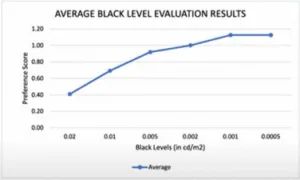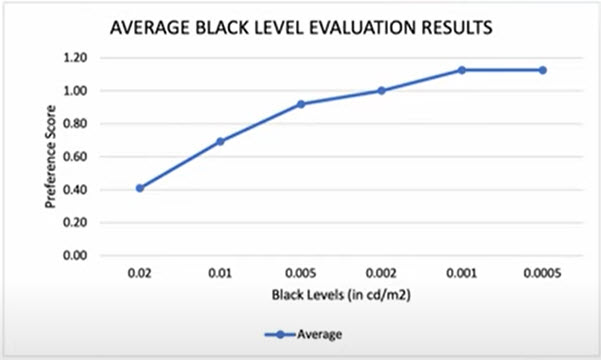In February, Sterling Silva of Paramount Pictures introduced an interesting webinar on what DCI, the organisation that coordinates digital content and systems in cinemas, thinks about what a true HDR experience is in theatres.
We’ve covered the challenges of achieving a true HDR experience and over the years we have reported on Barco’s work that showed that after a certain level of contrast in a projector, the level of contrast on the screen hardly changes as projector contrast ratios go up. We’ve also reported work by Dolby (Dolby Describes Theater Contrast Model and Measurement Data). Our own Pete Putman also showed how this works in domestic environments, too (Can a Display Be Too Bright?). Cinemas are looking at LED as an alternative to projection, so I was curious to see what DCI had to say.
Brian Vessa is from Sony Pictures Entertainment and chairs the DCI Technical Committee. He explained that in late 2017, DCI conducted 24 ‘double-blind’ image testing sessions at Walt Disney Studios using a state-of-the-art RGB laser projector. It showed specially optimised content and looked particularly at black levels. A second study in early 2020 used a Sony LED display (CLED) and focused on peak brightness levels in ten test sessions using 157 people from inside and outside the industry.
Feedback was solicited and conversations were very fruitful and DCI got good statistical data, Silva said.
Mike Zink of WarnerMedia shared the results. After covering the methodology and explaining the double blind process, he said that each clip was around 10 seconds long and was shown twice (A/B/A/B). Viewers were asked to rank the clips.
For black level testing, there were six clips, each prepared with multiple luminance and contrast ratings.
It was immediately clear from the results that lower black level versions, when compared with SDR, received better ratings. Analysis of the average shows user preference scores increasing with decreasing black levels, but the effect starts to wear off at black levels of around 0.005 cd/m². As a result, DCI concluded that black levels of 0.005 cd/m² are enough to give a compelling HDR experience and plans to use that as the requirement for the next generation of displays for cinema.
For peak brightness, 8 clips were prepared with different peak brightness (100-800 cd/m²) and graded by colourists for the CLED display. Four clips were used to really dig into the specific issue of peak brightness and again there was a clear result that content of above 100 cd/m² was preferred in all HDR cases and there was a significant increase at 300 cd/m² or above.
The different grades at 300 vs 500 and 500 v 800 cd/m² were ‘more or less’ rated the same, Zink said. So, as with black levels, there was not much change above 300 cd/m². As a result 300 cd/m² of peak brightness is considered enough to deliver a compelling HDR experience. As a result of the test, DCI plans to make 300 cd/m² the requirement for HDR displays.
The aim is to find the ‘sweet spot’ and DCI thinks this is at 300 cd/m² (which gives 60,000:1 contrast when combined with the black level requirement, by my calculation)
The next speaker was Annie Chang, VP of Creative Technologies at Universal Pictures and a member of the Technical Committee of DCI. She talked about the grading process for the peak brightness content. Colorists were asked to get the best grade at each level of peak brightness and each already had 48 cd/m² SDR and Dolby Vision 100 cd/m² grades. She said that the Sony CLED was used for the grading and viewing as it was the only technology at the time that could go from the very low black to the 800 cd/m² peak for the tests.
Chang explained that when the group tried to just ‘tonemap’ the 1,000 cd/m² home video masters down, the result was not satisfactory and that’s why new grades were made. Pixar also rendered three content items with different black levels and those were also creatively graded. Clips had been set to a length of 10 seconds, to keep the session lengths reasonable and avoid fatigue, but for the black levels, some clips had to be made longer (16-20 seconds) to allow some adjustment of the eye to the dark environment.
Clips were paired randomly, but with a bias towards comparing adjacent brightness levels as it was felt that comparing 300 to 500 was more useful than comparing 100 to 500. Nobody knew which was which until after the experiment.
Conclusion
This is an important piece of work, I think. Setting a target level based on good science for new cinema displays, especially LED displays, is a really added value process from DCI. It did get me wondering why, if 300 cd/m² and 60,000:1 contrast is enough for HDR in the cinema, why those making home TVs continue to push towards 2,000 cd/m². The answer, of course, is ambient light and its effect on black levels in most display technologies. Cinema is an environment that has very controlled lighting, the home is not.
The result clearly positions Dolby Cinema as a step towards HDR Cinema, but not as a full step. Still, no doubt, that will allow the firm to offer some kind of upgrade to Dolby HDR Cinema! (BR)




